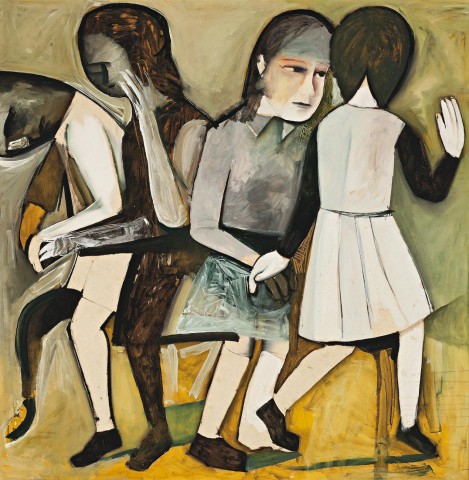PLAYGROUND, 1962
CHARLES BLACKMAN
oil on hardboard
153.0 x 150.0 cm
signed and dated lower left: Blackman 1962
inscribed with title verso: PLAYGROUND
Bonython Art Gallery, Sydney (label attached verso)
Rudy Komon Gallery, Sydney
Mercantile Mutual Insurance Co. Ltd, Sydney
Alan and Nola Geddes, Sydney
Estate of Nola Geddes, Sydney
Art from Collections of the Institutional Members of the Art Gallery Society of New South Wales, Blaxland Gallery, Sydney, 17 September – 2 October 1980, cat. 3
Rudy Komon Gallery Retrospective, Artmet, Sydney, 26 April – 21 May 1988, cat. 5 (label attached verso)
‘Formal Affair’, The Sydney Morning Herald, Sydney, 21 September 1980, p. 146
In June 1961, the year before Playground, 1962 was painted, Charles Blackman was included in the ground-breaking exhibition, Recent Australian Painting, at the Whitechapel Gallery, London, curated by Bryan Robertson.1 Of the artist’s submissions, the Observer newspaper’s art critic proclaimed that ‘the most moving – and the discovery of the exhibition – are the three remarkable paintings by Charles Blackman’.2 High praise indeed for the young Australian from a show that included the likes of Brett Whiteley, Russell Drysdale, Arthur Boyd and Sidney Nolan. Blackman and his family had relocated to London in January of that year, a move which followed a spectacular recent trajectory in his career which included his Alice in Wonderland series (1956 – 57) and participation in The Antipodeans (1959), before culminating in a sell-out exhibition at the Johnstone Gallery, Brisbane, in 1960 and his award of The Helena Rubenstein Travelling Scholarship later that same year.
In his decision to move to London, Blackman was following a mini-exodus of Australian artists, actors and writers who were already attaining celebrity status in the city. By his own admission, he initially was not keen to make the move fearing that he would lose the ‘authentic’ local flavour which he deemed crucial to his work. Arriving in the bleak winter, the family first moved into the home of Arthur Boyd before finding their own rented accommodation nearby. The following year, Blackman set up a studio ‘first in a chilly, moss-infected basement … in Highgate where he wore gumboots to keep out the damp, and later (September) in a large flat in Regent’s Park where there was room to both live and work.’3 Blackman had already established himself as a keen observer of humanity, particularly children, depicting their emotive lives in paintings full of gesture, veiled appearances and anxiety, underscored by a poetic sensibility. At the core was his unsurpassed graphic skill evident in associated drawings and also clearly visible in the underlying marks in The Playground. Such application was championed by Bryan Robertson who declared that Blackman’s were ‘some of the strongest, most urgent and forceful paintings by a young artist that I have seen in the past ten years’.4
Playground displays many of Blackman’s recognisable motifs such as the pensive expression on the principal girl’s face contrasting with the hidden faces of her companions; and the linkage of legs to convey the sensibility of a childhood dance. Also notable is ‘the immensely important use of hands to make contact. His people reassure one another by touching their hands together’.5 Blackman utilises a variety of mark making from broad brush to cross-hatched incisions into the paint’s surface which enhances the visual impact and gestural agitation of the final image. Its execution in mostly muted tones also heightens the sudden focus on the small slash of vermillion around the central figure’s eyes. Originally exhibited by Kym Bonython, one of Australia’s most significant gallerists, Playground is a bold yet accessible work from one of Charles Blackman’s most fertile creative periods.
1. Bryan Robertson subsequently orchestrated Blackman’s first London solo exhibition at the Mathieson Gallery in November 1961.
2. Pringle, J.D., Observer, London, 4 June 1961
3. Amadio, N., Charles Blackman: The lost domains, A.H. and A.W. Reed, Sydney, 1980, p. 54
4. Robertson, B., ‘Preface’, Paintings and Drawings: Charles Blackman, Mathieson Gallery, London, November 1961
5. Rosenthal, T.G., Arts Review, London, 4 November 1961
ANDREW GAYNOR
